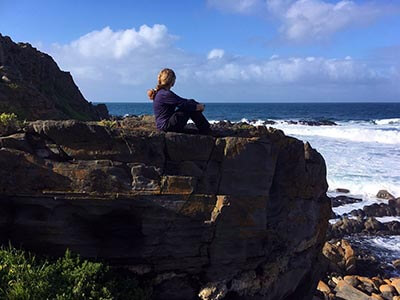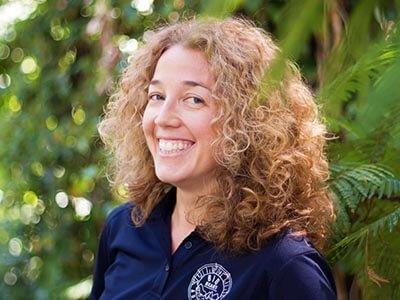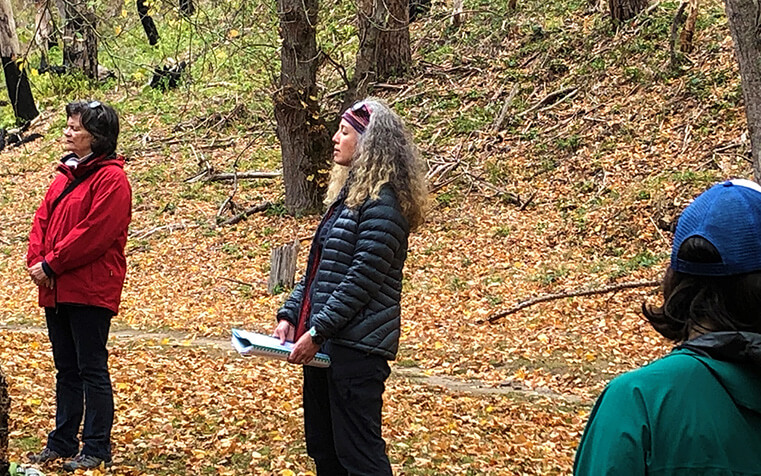Author: Lisa Murphy
How did my journey to Nature Therapy begin? Well, I can’t even remember what age I was when I realised that being out in nature felt good. I was not a typically outdoorsy kid, in fact I was an overweight bookworm who had a younger brother who would convince me every now and then to go a kick a football or play tennis with him. I agreed and thanks to him, I probably ended up with sports skills and abilities that would have never been uncovered (thanks bro).
I wouldn’t say I had a huge obsession with trees or plants, but I did love tree houses and cubby houses and remember clearly playing on a giant Moreton Bay Fig tree as a child at a Jaycee’s picnic somewhere near Naracoorte in the southeast of South Australia as a kid and being fascinated with the roots holding water. A tree holding water for birds and other animals stills blows my mind.
The joy, closeness and connection I felt to the human and More Than Human World when on trails or up on mountains was a discovery I made quite by accident – I realised I never felt lonely or disconnected from my family or friends despite the distance of being far away and often a long way from sea level. In fact, I felt a great closeness to my loved ones who had passed. Why was this?
I’d completed the Kokoda Track in 2012 with hubby, mum, cousins and friends and the effect this adventure had on me was so profound I made some big decisions while away and experienced one of the most emotional hiking journeys ever to that point in my life. It was also one of the most physically challenging. And so, wanting to recreate these experiences for others, I started a walking tour company in 2015 alongside my travel agency at the time. Initially, I started a walking program for women and became a walk leader, taking women overseas on life-changing treks and seeing firsthand the huge personal growth that would happen by taking women outside of their comfort zones in a safe and supportive way. I felt passionate about creating these experiences for others because I knew from experience that I could manage my own mental health so much better if I allowed myself these experiences as a way of growth, perspective shift and confidence building. The feedback from our walkers was similar.
So fast forward to 2018. I started introducing a mindful minute into our day walk program – stopping for just 60 seconds to experience silence (eyes closed or not) to focus on what else we could sense. I didn’t realise but I suggested focusing on hearing different sounds if the mind was struggling with “monkey chatter”. Little did I realise this was a very basic form of nature therapy. Our walkers thanked us for adding this in and said it was in some cases the most memorable part of the walk. When our walkers were asking for this on most walks and some even asking for longer, I delved deeper into understanding why we all felt so good after these 60 seconds of silence.
The studies were appearing about doctors prescribing walks in the US and UK and green time instead of screen time, and I realised without the qualification of a therapist of some kind e.g. social worker, psychologist, psychiatrist or doctor, I would have little chance of convincing people to join me to feel the therapeutic benefits of walking in nature.
By chance I saw a short course advertised while taking the train one morning into work in January 2020 all about an Introduction to Shin-rin Yoku (directly translated from Japanese as Forest Bathing) and while the term immediately took me to a visualisation of getting naked under trees, the photo of the forest and my memories of walking amongst giant Sugi (cedar) and Hinoki (cypress) trees on the Kumano Kodo in 2018 overcame me. The Kumano Kodo trek was one of the most healing pilgrimages I had ever been on – on this journey I had some big decisions to make and felt at such a difficult crossroad with what was my next steps. I had brought a bit of baggage with me on that trek. In just 5 days I found myself for the first time in months finding absolute clarity in my thinking. I stopped mid hike on the final day as we approached Nachi-san to record the epiphany that was the solution in my journal. This was the impact this pilgrimage had on me.
Before I knew it, I had paid for the course on my credit card and sat in the train waiting to log in and start reading.
This was when COVID19 was starting to appear in our lives. For the next year or so, we watched our travel agency (and the office we had moved into for just 12 months) disappear in front of us. The all-consuming pandemic meant the travel industry would cease to exist for a while and I would find myself in a government job, juggling a business and somehow, studying life coaching and then finally that magical short course that I had shelved.
Once I started, I literally could not stop studying it. I finished the course in less than 2 weeks, passed the assignments and was like “now what?”.
I investigated courses for how to become a Guide with a couple of providers in Australia but with no remote learning on offer and limited dates with all kinds of restrictions still in place preventing in person training, I discovered a 100% remote learning course offered from ANFT – Association of Nature and Forest Therapy with rolling enrolments – I could start the course in our “off season” before walking started in April. Perfect!
The first session online meeting all my cohort buddies from the northern hemisphere was just incredible and I soon forgot that it was the middle of the night with the time zone difference. Hearing everyone’s introductions and why they were in the course too left me feeling like I had another family all over the globe that felt the same as me, had a similar journey and it was incredibly validating. I was pumped.
One of the live virtual walks we did together as a group some weeks later was equally powerful and despite time difference and distance, we shared the most amazingly connected experience in nature. I have since listened to the recording of that walk and still feel a connection to the community on the walk that day even though we didn’t see each other in person or share the same space physically. It was a synchrony that I don’t have words for.
Studying each subject topic has allowed a slow and gradual examination of all aspects of Forest Therapy Guiding broken down into beautiful bite-sized chunks and knowing I am not a therapist (despite the thinking that I needed to be one to facilitate these experiences) is exactly what being a Guide is about. The forest is the therapist – the guide opens the doors. Being an empath, this was a relief as I always thought I had to be a social worker or a counsellor or a psychologist to make a difference. I always found working the social science/social work realm quite draining and I left the field for teaching (oops another draining role) and so it was clear an empath might not be the right fit for working in that space. I considered becoming a counsellor or psychotherapist but realised it had the same feeling as a social worker role and I just couldn’t become that role and not feel compassion fatigue.
The course has encouraged me to adopt the practise of sit spot. I have connected with my local park that has introduced me to a family of magpies, rainbow lorikeets, fungi, melaleuca trees, banksia and gum trees. Admittedly it looks like rocks and logs have been placed around a beautiful tree space deliberately but of course this drew me in. The rocks I sit on are placed in such a way that I can choose a different spot to sit or the same spot each time and just observe what is happening in this place. I pick up the rubbish I see and keep it tidy. I feel like I have adopted this park as my own and get a bit protective if I see the council truck coming to remove tree branches or prune even! I started to sketch here, journal and record what I was seeing, and it felt good. I would sometimes start at sunrise (most of the time well after sunrise) and sit for 20 minutes minimum. If I started writing or drawing sometimes it would be longer.
The act of deliberate engagement has really made the process of connection smoother for me. I just grab my journal and go, rugged up and ready to witness mother nature’s gifts before I start my day. Some of the sunrises have been incredible. I find sit spot a really easy way to find space and while I would normally go for a run to experience the endorphin release, I find on days of low energy or not feeling 100%, sit spot has a big impact on my attitude towards the day. It brings clarity and motivation. So, if feeling unmotivated, go and sit for 20 mins (or longer) under a tree or on grass or in your garden and see if that improves how you feel. I highly recommend it!
To discover the benefits of Nature Therapy check out my calendar for upcoming sessions.



